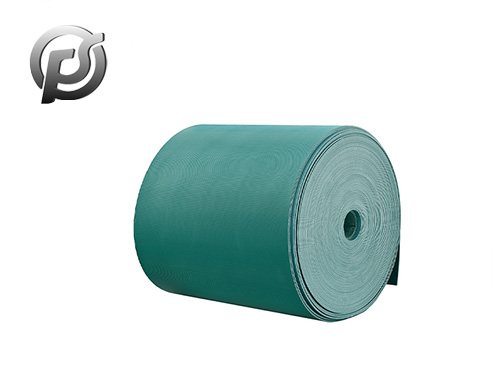Rubber high temperature resistant
conveyor belt is mainly used in metallurgy, building materials and other industries of sinter, coke, cement clinker transportation, applicable conditions for the surface temperature does not exceed 200℃, material temperature does not exceed 500℃ occasions. But so far, the EP polyester conveyor belt used in the conveying of sinter, coke and cement clinker in metallurgy, building materials and other industries can transport materials with an instant temperature of 500℃. The design considers the instant aging resistance. When conveying materials, the temperature when the materials are transferred to the core cannot exceed 200℃, so the materials must dissipate heat quickly. Only its own can not accumulate temperature rise, can be used to transport high temperature materials; In terms of heat resistance, the high-temperature resistant conveyor belt satisfies the conveying of high-temperature materials in metallurgy, building materials and other industries, but it has major defects in terms of safety performance, which are as follows:
Due to the low oxygen index of rubber, the belt made of no added flame retardant is not flame retardant. If the conveyor line is abnormal and the material stops, the material temperature can not be quickly transferred to the external environment. Once the ignition point of rubber is reached, the burning phenomenon of rubber belt will be generated, which affects the normal use. The design considers the adhesion strength at high temperature rather than safety performance, and once the abnormal situation occurs, such as the temperature of the belt body more than 260℃, the core will melt and fuel combustion, causing greater losses, in view of the above shortcomings of the high temperature resistance belt, metallurgical building materials industry needs to use a high temperature resistance and flame retardant conveyor belt to replace.
By overcoming the shortcomings of the existing technology, a kind of working surface covering adhesive which can not only maintain the original heat resistance performance of the high temperature resistant belt, but also maintain the good flame retardant performance of the flame retardant conveyor belt can be applied. The specific optimization and improvement process is as follows: In its plasticizing process ethylene content ethylene propylene rubber in the open mixer plasticizing machine, mixer mixing, first add plasticizing good ethylene propylene rubber, antioxidant, hard cool acid, petroleum softener, reinforcing carbon black refining for 20 minutes, and then add zinc oxide, magnesium oxide, paraffin, rubber belt hot vulcanizing machine temperature control at 100 to 130℃, after the mixer discharge, Then, it is put into the mixer for 4 hours, and then it is added with diisopropyl benzene peroxide, vulcanized resin and crosslinking agent. Finally, the sheets are taken out and sent to the normal temperature pool for water cooling. The water-cooled films are stacked for calensing out. The rubber material is heated to 60℃. Finally, after preheating the three-roll or four-roll calendering machine to 80℃ in the sheet pressing process, the hot film mixer is calendering on the three-roll or four-roll calendering machine and the sheet can be completed.
After the covering adhesive produced by this optimization process is used in the conveyor belt products of metallurgy, building materials and other industries, the working belt can not only inherit the original heat resistance of the high temperature belt, but also have the good characteristics of flame retardant tape, and the preparation method of this high temperature resistance flame retardant covering adhesive has the advantages of high production efficiency and stronger operability.
 Optimizing Operations with PE Conveyor Belts: Durability, Efficiency, and Versatility
Optimizing Operations with PE Conveyor Belts: Durability, Efficiency, and Versatility
 Exploring the Efficiency and Versatility of Light Conveyor Belts
Exploring the Efficiency and Versatility of Light Conveyor Belts
 Polyester Conveyor Belts: Enhancing Efficiency and Reliability in Material Handling
Polyester Conveyor Belts: Enhancing Efficiency and Reliability in Material Handling